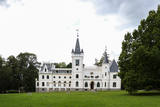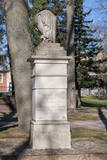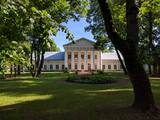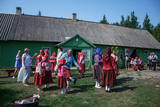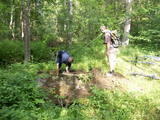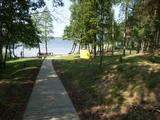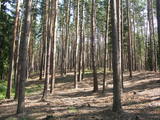| Нo | Название | Описание |
|---|---|---|
|
Located at the Lake Burtnieks southern shore, these are wetland meadows which are regularly flooded and which are important places for various birds, including the corn - crake, to nest. This is part on the environmentallyrestricted area which covers the meadows of Lake Burtnieks. |
||
|
Земгальский регион - плодородная равнина. Здесь есть много современных земледельческих хозяйств, среди которых есть и такие, которые предлагают познакомиться с сельской жизнью и наследием сельскохозяйственной истории. Путешествие начинается в Риге и продолжается по «Млечному пути» - экскурсией на молочную ферму. Затем Елгава, столица бывшего Курляндского герцогства (16-18 в.в.), с историей которой можно ознакомиться, посетив интерактивную музейную экспозицию в Башне Елгавской церкви Святой Троицы и полюбовавшись панорамой города с 9-го этажа. Далее на сельском дворе вас ждет рассказ о латышских традициях и выпечка хлеба вместе с хозяйкой. После этого – знакомство с зерноводческим хозяйством, где можно осмотреть коллекцию оборудования для переработки молока, а для детей оборудован парк развлечений. |
||
|
Из Риги маршрут идет на козью ферму, где можно пообщаться с милыми смешными животными и отведать эксклюзивные сыры. Затем посетите поместье Малпилс и отведайте ассорти из местных сыров, изготовленных из коровьего молока. Потом маршрут поворачивает в сторону реки Даугавы и ведет в Скривери, где можно попробовать восхитительное домашнее мороженое и традиционные ириски «Коровка» ручной работы. А затем направляйтесь к развалинам легендарного Кокнесского замка. На следующий день маршрут идет в этнографическое действующее фермерское хозяйство, расположенное в живописном местечке под названием Яунпиебалга, и в семейное предприятие по производству сыра и макаронных изделий в Рауне. Неподалеку находится производство глиняных изделий, расположенное в стенах бывшего кирпичного завода, где можно понаблюдать за тем, как вручную изготавливаются керамические изделия. Затем вас ждет осмотр достопримечательностей в Цесисе, с его Старым городом и средневековым замком Ливонского Ордена. А далее, маршрут ведет на ферму, где выращивают коноплю, и где вы сможете попробовать ее, приготовленную традиционным способом. Далее по плану экскурсия и дегустация на фабрике мороженого в Руйиене. Остановитесь на бывшей мельнице, где до сих пор используется и можно посмотреть старинное оборудование для обработки шерсти. На пути обратно в Ригу, маршрут ведет вдоль побережья. Посетите музей величайшего в мире лгуна – Мюнгхаузена, где вас развлекут историями о его фантастических приключениях, навестите ловцов миног и прогуляйтесь по песчаному пляжу. |
||
|
Построен в первой половине 19 века, в стиле неоготики Тюдоров. Первым владельцем замка стал барон Иоанн Готлиб фон Вольф. В 70 – 80 годах того же века его перестроили в стиле французского неоренессанса. Во время революции 1905-го годa замок сожгли, однако восстановили, введя в его облик формы модерна. Замок можно осмотреть изнутри, предлагаются экскурсии. |
||
|
В 1877 году, отдавая дань заслугам предков в создании Нейбаде, барон Август фон Пистолкорс велел соорудить в парке памятник. После Первой мировой войны, в 30-е годы, памятник случайно был обнаружен при очистке русла реки Кишупе. Общество помощи и благоустройства Нейбаде памятник восстанавливает и в 1933 году его заново открывают. Памятник пострадал и после Второй мировой войны. В настоящее время памятник восстановлен и находится в парке эстрады. |
||
|
Усадьба Салос и ее парк расположены на острове озера Двирагис, чьи контуры с высоты птичьего полета напоминают силуэт Литвы на географической карте. В восточной части усадьбы находится парк смешанной планировки. Это один из старейших парков в Литве. Еще во времена хозяйствования Радзивиллов здесь был лесопарк с запретом на вырубку деревьев. В парке преобладали лиственные деревья местных пород: клены, липы, ясени, тополя сереющие, которым сейчас сравнялось двести лет. По берегу озера проходила тропа, соединявшая аллею с парковой дорожкой. Сегодня здесь сохранились зеленые насаждения, фрагменты аллей. |
||
|
The tour introduces modern day life in rural Finland, Estonia and Latvia and includes visits to small farms raising livestock and producing delicious foods, and to ethnographic villages preserving the traditional lifestyle in a contemporary environment. The tour also involves sites of historical and cultural interest. |
||
|
Предлагают экскурсию по богатому и живописному питомнику, в котором насчитывается около 3000 видов, пород и форм растений. Широкий ассортимент водных растений, можно приобрести саженцы и получить консультацию по их выращиванию. |
||
|
Kihnu is the largest island in the Gulf of Riga, with an area of 16.4 km2. It is only 7 km long and 3.3 km wide. Kihnu's cultural space and traditions are included on the UNESCO List of the Intangible Cultural Heritage of Humanity. There are four villages on the island and the islanders still wear national dress as everyday apparel. The unique atmosphere of the island can be experienced during a guided day programme. Kihnu Mare, the local guide, has developed her own traditional culture network with the people who have the know-how and skills to demonstrate for visitors the different aspects of Kihnu culture: the language, the traditional clothes, farming and fieldwork, handicrafts, the preparation of traditional foods, folklore, church life, singing, and dancing at weddings and village parties, as well as their traditions surrounding the sea, fishing, seal hunting and living with nature. |
||
|
Домашний ресторан на острове Кихну, хозяева которого готовят щедрое угощение, используя местные островные продукты ‒ в основном рыбу. |
||
|
Muiža vēsturiskajos dokumentos pirmoreiz ir pieminēta 16. gs. Tagad redzamā vienstāva kungu māja ir vairākreiz pārbūvēta laikā no 17. – 19. gs. 1997. g. ēku vēlreiz atjaunoja un tagad tajā atrodas viesu nams un Vilsandi nacionālā parka apmeklētāju centrs, kur var iegūt ne tikai vērtīgu informāciju, bet arī apskatīt Vilsandi apkārtnē atrastās fosilijas. No Lonas muižas var uzsākt pārgājienu uz Vilsandi salu. Vienā no muižas ēkām ir izveidota Vilsandi nacionālajam parkam veltīta ekspozīcija. |
||
|
Остатки серного источника "Лягушечка"
– сегодня только знаток или старательный
поисковик в лесу между гостиницей "Кемери" и
"Межа Мая" найдет место когдато известного,
но уже бывшего серного источника, который
опознается по поврежденным человеком и
временем железобетонным конструкциям.
|
||
|
Комплекс отдыха расположен на берегу искусственного водохранилища, на территории имеются две бани - Большая и Малая. Здания Большой и Малой бани предусмотрены для проведения торжеств и различных мероприятий. Вместимость Большой бани до 40 человек, в летний сезон - до 60, а Малой бани - до 20 человек. Кроме бань предлагаются 20 мест для всевозможного отдыха: столики, гриль, места для палаток, волейбольная площадка, прокат лодок и водного велосипеда. |
||
|
Судрабкални – бывшая аптека, до конца восьмидесятых годов прошлого столе-
тия – амбулатория, позднее – средняя школа, сейчас – частный дом.
|
||
|
Ein der ethnografischen Dörfer in Dzūkija mit Holzgebäuden und Kruzifix. |
||
|
There is a small and relatively hard to reach area on the western shore of Lake Būšnieks which has been restricted to protect swamp habitats and several protected plants. Boat base is on the northern shore of the lake offers boat rental. From the plank-way good sites of eutrophic part of Lake Būšnieks can be seen. A well-appointed recreational facility (not included in the restricted area) is on the opposite shore of the lake. |
||
|
Mailīšu fabrika atrodas Ērgļos, un tā ir radīta ar mērķi saglabāt rokdarbu tradīcijas un prasmes. Te auž vilnas, lina un zīda darbus - segas, plecu lakatus, linu dvieļus. Viesiem ir iespēja apskatīt dažādu veidu stelles, kuras izmantotas Latvijas teritorijā jau sākot no 9.gs. |
||
|
Aizaudzis un purvains ezers - Ļūbasts, ar grūti pieejamiem vai nepieejamiem krastiem. Dabas vērošanai šobrīd nepiemērota vieta. Galvenās aizsargājamās vērtības - dažādas putnu sugas, t.sk. dzērves un melnie zīriņi.
|
||
|
Ein 3,5 km langer Pfad quert den Viru Moos in Richtung Süd–Nord. Von einem Holzaussichtsturm eröffnet sich einen Blick auf eine typische Hochmoorlandschaft mit einigen Seen, Aushöhlungen und morastigen Stellen. |
||
|
Находится на главной пешеходной улице города. Пекут пирожки с салом, ватрушки, булочки с корицей, крендели и торты. Предлагают аренду стильных велосипедов vintage. |
||




